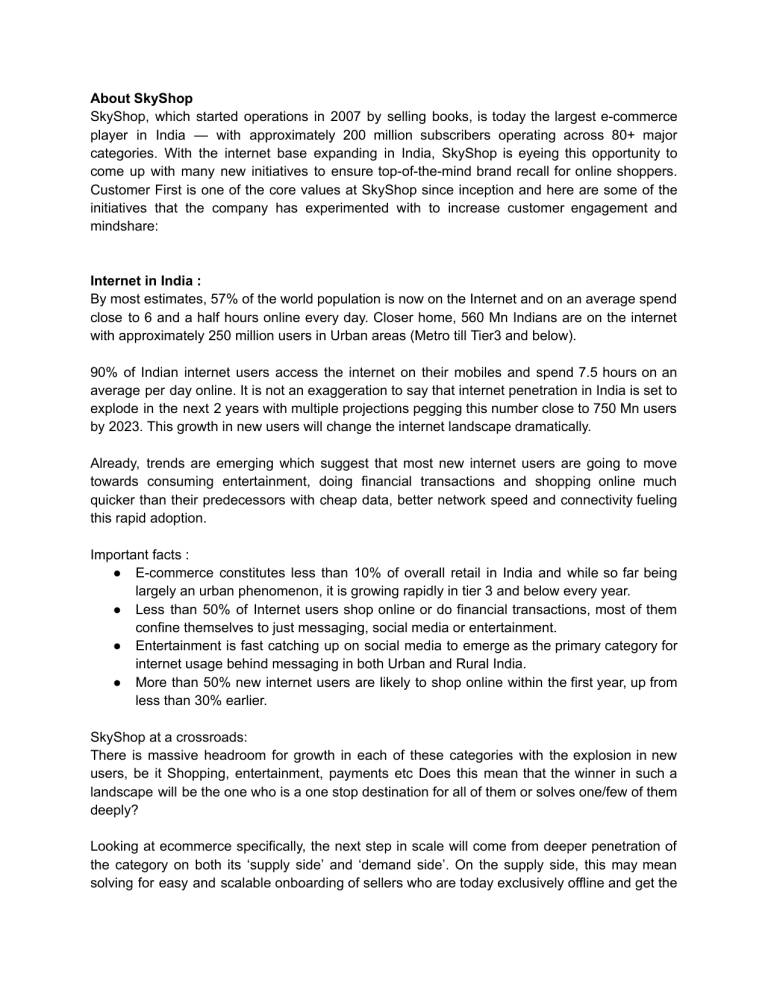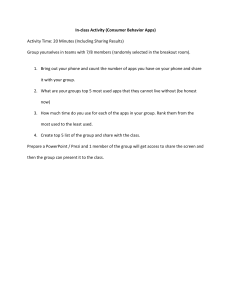
About SkyShop SkyShop, which started operations in 2007 by selling books, is today the largest e-commerce player in India — with approximately 200 million subscribers operating across 80+ major categories. With the internet base expanding in India, SkyShop is eyeing this opportunity to come up with many new initiatives to ensure top-of-the-mind brand recall for online shoppers. Customer First is one of the core values at SkyShop since inception and here are some of the initiatives that the company has experimented with to increase customer engagement and mindshare: Internet in India : By most estimates, 57% of the world population is now on the Internet and on an average spend close to 6 and a half hours online every day. Closer home, 560 Mn Indians are on the internet with approximately 250 million users in Urban areas (Metro till Tier3 and below). 90% of Indian internet users access the internet on their mobiles and spend 7.5 hours on an average per day online. It is not an exaggeration to say that internet penetration in India is set to explode in the next 2 years with multiple projections pegging this number close to 750 Mn users by 2023. This growth in new users will change the internet landscape dramatically. Already, trends are emerging which suggest that most new internet users are going to move towards consuming entertainment, doing financial transactions and shopping online much quicker than their predecessors with cheap data, better network speed and connectivity fueling this rapid adoption. Important facts : ● E-commerce constitutes less than 10% of overall retail in India and while so far being largely an urban phenomenon, it is growing rapidly in tier 3 and below every year. ● Less than 50% of Internet users shop online or do financial transactions, most of them confine themselves to just messaging, social media or entertainment. ● Entertainment is fast catching up on social media to emerge as the primary category for internet usage behind messaging in both Urban and Rural India. ● More than 50% new internet users are likely to shop online within the first year, up from less than 30% earlier. SkyShop at a crossroads: There is massive headroom for growth in each of these categories with the explosion in new users, be it Shopping, entertainment, payments etc Does this mean that the winner in such a landscape will be the one who is a one stop destination for all of them or solves one/few of them deeply? Looking at ecommerce specifically, the next step in scale will come from deeper penetration of the category on both its ‘supply side’ and ‘demand side’. On the supply side, this may mean solving for easy and scalable onboarding of sellers who are today exclusively offline and get the ‘bazaars’ of India online as well as expanding the supply chain network and fulfillment centers to reach these new users. This could potentially mean SkyShop building new capabilities or forging partnerships to strengthen the foundation for eCommerce 2.0 On the demand side, getting these new users to start shopping may require players to not just be a shopping destination, they need to cater to their other needs like entertainment, financial services and hence may require SkyShop to pivot away from just being a shopping destination. Globally, internet companies have taken different routes to this end. In China, the progression towards “Super apps” has ensured that customers can find everything they need on a single app. Customers use apps like WeChat, Meituan Dianping etc for a wide range of activities like entertainment, flight/hotel bookings, messaging, news, financials services like loans and investments etc These apps either fully own these different verticals or partner with different players, like JD.com in Wechat’s case (e-commerce on a messaging app), to provide the required offering. Another example is, WeChat Pay being offered as part of an ‘ecosystem’ of offerings to other apps, like PinDuoDuo who integrate it fully in their experience and thus can tap into WeChat’s existing user base to acquire new customers while WeChat gets the benefit of increased transactions outside the WeChat app. These “ecosystem” or “hybrid” routes which the Chinese internet companies have taken has resulted in an accelerated customer base & revenue growth. In the US, this has played out differently. The big internet companies offer different apps for different needs but either “fully own” or “control” a part of these apps. For example, Google lets you book flights(google flights), watch videos (Youtube), do video calling (Duo) via different apps but owns them completely. Consumers still need to download these apps individually and have a distinct experience on each of them. Same is the case with Facebook, Instagram and Whatsapp, three distinct apps catering to almost 3 different needs under the overarching umbrella of allowing people to connect socially. But there are winds of change in the US. Uber has started food delivery branching out of their existing ride hailing offering, AirBnB is venturing into ‘experiences’ beyond just accommodations, Instagram is trying to integrate “shopping” by working closely with brands and influencers and Apple is venturing into ‘content’ and ‘credit’ but what is common amongst all of these examples is that they have chosen to completely control the experience and hence deliver greater customer satisfaction and thus better retention of users. To put it succinctly, while China has taken the “ecosystem” route with big internet apps choosing to host different partners or opening their own services to be used by other partners to unlock scale for all the players in the ecosystem, US has taken the “Fully controlled” route with each App solving for one consumer need completely and fully control the customer experience before moving on to something else. SkyShop today is at this crucial juncture. An internet pioneer in India looking to chart out its growth strategy in a rapidly changing consumer landscape. The questions confronting you today, for the purpose of this case study : ● Looking at Global case studies, if you had to suggest to us, which route would you recommend: The ‘ecosystem’ route or the ‘fully owned’ or a hybrid of the two. ● How will the chosen route translate on the demand side? What should SkyShop “be” for the customers? Should they see SkyShop as a destination for everything they need or should there be different apps within the SkyShop umbrella for their different needs? ● Based on the answer to the first question, what should SkyShop do on the “supply” side? Does it mean venturing into new verticals like OTT, travel tickets/bookings, financial services via partners or fully owned? What does it mean in the supply chain side, should we work with 3rd parties like Delhivery to scale reach and fulfilment centers or fully own the network to provide the best experience to e-commerce customers? Should we scale the seller base by developing easy onboarding to offer ‘local’, ‘regional’ and widest range of products to our customers or continue to scale steadily while continuing to strongly guardrail quality? Key Deliverables ● Recommend the right strategy for SkyShop. Bring in the relevant Indian context in your recommendation. You may use current internet trends in India, global evolution of internet and primary research to substantiate your view ● Demand side : How does your chosen strategy translate on the demand side? Provide 3-4 key areas where and how this strategy will be deployed and provide a timeline view of implementation and key customer metrics that it will move : Daily active users, Monthly active customers, Repeats etc ● Supply side : Provide 3-4 key areas where and how the chosen strategy will be deployed. Provide a timeline view of implementation with key supply side metrics it will move : Number of active sellers/partners, Number of listings/products/hours of content etc



